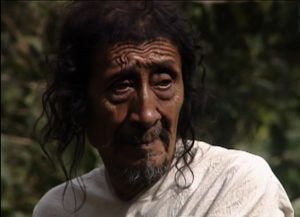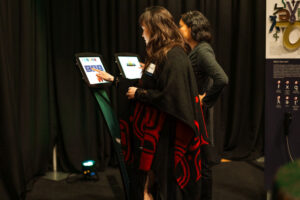
Filmmaker Steve Bartz in Chiapas, Mexico. Photo: James D. Nations, 2018
It was October 1996, and Terralingua was, officially, less than three months old. We had incorporated as a nonprofit organization under U.S. law at the end of July of that year. We were infants—but infants with a big vision and far-reaching goals. We believed that linguistic diversity, cultural diversity, and biodiversity are interlinked and interdependent as manifestations of the diversity of life on earth. And we had set out to educate ourselves and the public about the vital role of diversity—in both nature and culture—for the survival and thriving of all life.
We started out with a bang. That October, we held an international working conference, titled “Endangered Languages, Endangered Knowledge, Endangered Environments,” at the University of California, Berkeley (UC Berkeley). The conference brought together 35 or so researchers, practitioners, and activists, both Indigenous and non-Indigenous, to explore an idea that we would later begin to call “biocultural diversity” and its implications for both knowledge and action. It was the event that launched Terralingua on a journey that continues today, nearly a quarter of a century later. (You can read about the outcomes of that conference in the edited volume On Biocultural Diversity: Linking Language, Knowledge, and the Environment—published by Smithsonian Institution Press in 2001—which has become one of the foundational texts in the field.)
Steve Bartz, who sadly passed away earlier this year, was there, too. Then a young, talented filmmaker living in Berkeley, Steve had already garnered major recognition: the CINE Golden Eagle award for excellence in international documentary film and video production, for co-producing (with Jaime Kibben) the film In Good Hands: Culture and Agriculture in the Lacandón Rainforest. The movie told the story of the Lacandón Maya of Chiapas, Mexico, and their efforts to maintain their way of life and preserve the rainforest in which they live. With what I would come to learn was his typical generosity, Steve had agreed to perform an unglamorous task at the conference: filming the entire three days of proceedings to create a full record of that inaugural event. (I still have the dozen or more VHS tapes—if anyone can remember what those are—that resulted from that effort. And one of these days I will get around to turning them, or at least salient bits of the content, into a digital format that biocultural diversity history buffs can access!)

Filmmaker Steve Bartz (back) stands with the Valenzuelas, a Lacandón Maya family, in Mensäbäk, Chiapas, Mexico, in May 2018. Steve documented Lacandón life, language, and traditional knowledge in several award-winning films. Valenzuela family members are, left to right: Cecilia, Chan K’in, Tomasina, Minchu, Bor, Adela, Amalia, and Araceli. Photo: James Nations, 2018
In the following years, Steve Bartz continued his documentary work in Mexico, filming an historic encounter between the Lacandón Maya and a group of Itza Maya visiting from Guatemala. The two peoples are linguistically and culturally related, but the circumstances of colonial history had long separated them. Also participating in the meeting were conservationists working in the region to protect the rainforest from the encroachment of logging, ranching, and other external pressures. In that moving encounter, the Lacandón and Itza discovered not only their common roots, but also a shared determination to meet the challenges that threatened (and still threaten) their forest home and ways of life. The film, “To the Roots: A Maya Reunion,” produced in 1998, is a beautifully shot, deeply empathetic account of that memorable event.

Scene from To the Roots: A Maya Reunion. Video: Steve Bartz, 1998
Seeing “To the Roots” at that time gave me the idea for another project: showcasing Steve’s film and a few other documentaries about Indigenous Peoples from around the world engaged in defending their languages, cultures, and lands. I talked to Steve and he was immediately game to collaborate. Together, we put together a mini biocultural diversity film fest that in 1999-2000 we showed in three major venues: The Field Museum of Natural History in Chicago, The Smithsonian Institution in Washington, DC, and the Berkeley Natural History Museums at UC Berkeley. It was Terralingua’s first foray into presenting the idea of biocultural diversity to a non-academic audience—and, thanks to the power of visual media, it was a success in all three settings.
Fast forward to 2020. The work of Terralingua has since gone a long way in putting biocultural diversity on the map not only in academia, but also among a broader public. Today, our main outreach vehicle is our flagship publication, Langscape Magazine, which illustrates the idea of biocultural diversity through written and visual stories, poetry, and artwork. And that’s where Steve comes in again—or the memory of him, at least.
Just a few days ago, the shocking news reached me that Steve had passed away, suddenly and unexpectedly at age 54, back in January, pre-COVID-19. The news of his untimely death really hit me. In an instant, it brought me back “to the roots:” both the roots in the title and theme of Steve’s film and the roots of Terralingua, to which he had been so intimately connected. I immediately started thinking of how to commemorate him, and it came to me right away. We were about to publish a Langscape story about the “Lacandón Maya, The Through Line,” written by James Nations—one of the conservationists who were working with the Lacandones at the time Steve filmed “To the Roots,” and who was featured in the film! What if, to honor Steve, we posted the film as a complement to Jim’s story?
Thanks to the generous permission of Steve Bartz’s brothers, Robert and Richard Bartz, and to Jim’s prompt action in making a digital copy of the video available to us, we’re delighted to be able to present the film to Langscape readers (watch it here). The video’s grainy quality shows the passage of time, but the events are timeless. As you’ll read in Jim’s story, the Lacandón Maya still live in the rainforest of southern Mexico and continue to valiantly defend it against the assaults that increasingly threaten their forest home. Having declared their lands Áreas de Conservación de Flora y Fauna (Flora and Fauna Conservation Areas), they patrol them regularly to ward off intruders. As Jim puts it, today “they blend data from topographical maps and digital cameras with knowledge gathered while hunting with their fathers and from folktales told around the fire. Contemporary Lacandones carry walkie-talkies instead of bows and arrows.”
Together, Jim’s article and Steve’s film tell a story of enormous challenges, extraordinary resilience, and strong determination—a story that is common to Indigenous communities worldwide. I hope that, together, text and video will give you food for thought on the “inextricable link” between linguistic, cultural, and biological diversity. And I hope that, by reading and viewing, you will be—like I was—transported “to the roots.”
To learn more about Terralingua’s roots, read the Our History page on our website and browse the Langscape stories by David Harmon and Ken Wilson, written on the occasion of Terralingua’s 20th anniversary in 2016.
Luisa Maffi
Terralingua Co-founder and Director
Langscape Magazine Editor
A Note About the Author: Luisa Maffi, PhD (University of California at Berkeley, 1994), is one of the pioneers of the concept and field of biocultural diversity—the intertwined diversity of life in nature and culture. Trained in linguistics, anthropology, and ethnobiology, in 1996 Dr. Maffi co-founded Terralingua, an international nonprofit devoted to research, education, policy, and outreach on biocultural diversity. She has led the organization first as President (1996-2006) and then as Director (2007–pres.). Launched with the interdisciplinary conference “Endangered Languages, Endangered Knowledge, Endangered Environments” (Berkeley, California, 1996), Terralingua has been a leading organization in the field of biocultural diversity. Its program of work has been funded by charitable foundations in the USA and Canada. Since 2015, Maffi has also been Editor of Terralingua’s flagship publication, Langscape Magazine, which publishes biocultural-themed articles, poetry, photo essays, videos, and artwork by contributors from all over the world.




